Hopf Bifurcation Analysis for a Semiratio-Dependent Predator-Prey System with Two Delays
Abstract
This paper is concerned with a semiratio-dependent predator-prey system with nonmonotonic functional response and two delays. It is shown that the positive equilibrium of the system is locally asymptotically stable when the time delay is small enough. Change of stability of the positive equilibrium will cause bifurcating periodic solutions as the time delay passes through a sequence of critical values. The properties of Hopf bifurcation such as direction and stability are determined by using the normal form method and center manifold theorem. Numerical simulations confirm our theoretical findings.
1. Introduction
m ≠ 0, n ≥ 0, and ai(t), ri(t), b1(t), (i = 1,2) are assumed to be continuously positive periodic functions with period ω. Zhang and Lu [4] established the existence of positive periodic solutions of system (1), and sufficient conditions for the uniqueness and global stability of the positive solutions of system (1) were also obtained by constructing a Lyapunov function.
The rest of this paper is organized as follows. In Section 2, sufficient conditions are obtained for the local stability of the positive equilibrium and the existence of Hopf bifurcation for possible combinations of the two delays in system (3). In Section 3, we give the formula determining the direction of Hopf bifurcation and the stability of the bifurcating periodic solutions. Finally, numerical simulations supporting the theoretical analysis are also included.
2. Stability of the Positive Equilibrium and Local Hopf Bifurcations
Case 1 (τ1 = τ2 = 0). Equation (8) becomes
-
(H1) A + B + C > 0 and D + E > 0.
Case 2 (τ1 > 0, τ2 = 0). Equation (8) becomes
Therefore, if condition (H2) holds, the transversality condition is satisfied. From the analysis above, we have the following results.
Theorem 1. If conditions (H1) and (H2) hold, then the positive equilibrium of system (3) is asymptotically stable for τ1 ∈ [0, τ10) and unstable when τ1 > τ10. System (3) undergoes a Hopf bifurcation at the positive equilibrium when τ1 = τ10.
Case 3 (τ1 = 0, τ2 > 0). Equation (8) becomes
Obviously, if condition (H1) holds, then . Namely, if condition (H1) holds, then the transversality condition is satisfied. Thus, we have the following results.
Theorem 2. If condition (H1) holds, then the positive equilibrium of system (3) is asymptotically stable for τ2 ∈ [0, τ20) and unstable when τ2 > τ20. System (3) undergoes a Hopf bifurcation at the positive equilibrium when τ2 = τ20.
Case 4 (τ1 = τ2 = τ > 0). Equation (8) can be transformed into the following form:
-
(H3) Equation (31) has at least one positive real root.
Suppose that (H3) holds. Without loss of generality, we assume that (31) has four real positive roots, which are denoted by v1, v2, v3, and v4. Then (29) has four positive roots , k = 1,2, 3,4.
It is easy to see that if condition (H4)PRQR + PIQI ≠ 0, then . Therefore, we have the following results.
Theorem 3. If conditions (H1) and (H4) holds, then the positive equilibrium of system (3) is asymptotically stable for τ ∈ [0, τ0) and unstable when τ > τ0. System (3) undergoes a Hopf bifurcation at the positive equilibrium when τ = τ0.
Case 5 (τ1 ≠ τ2, τ1 > 0 and τ2 > 0). Considered the following:
We consider (8) with τ2 in its stable interval and regard τ1 as a parameter.
Let () be the root of (8), and then we can obtain
If condition (H1) D + E > 0 and (H2) D − E < 0 hold, then F(0) = D2 − E2 < 0. In addition, F(+∞) = +∞. Therefore, (39) has at least one positive root. We suppose that the positive roots of (39) are denoted as . For every fixed , the corresponding critical value of time delay
-
(H5) .
Therefore, we have the following results on the stability and bifurcation in system (3).
3. Direction and Stability of the Hopf Bifurcation
In this section, we will investigate the direction of Hopf bifurcation and stability of the bifurcating periodic solutions of system (3) with respect to τ1 for τ2 ∈ (0, τ20). We assume that τ2* < τ1* where τ2* ∈ (0, τ20).
Then, A(0) and A*(0) are adjoint operators. From the discussion above, we can know that ±iω1*τ1* are the eigenvalues of A(0) and they are also eigenvalues of A*(0).
In conclusion, we have the following results.
Theorem 5. If μ2 > 0 (μ2 < 0), then the Hopf bifurcation is supercritical (subcritical); if β2 < 0 (β2 > 0), then the bifurcating periodic solutions are stable (unstable); if T2 > 0 (T2 < 0), then the period of the bifurcating periodic solutions increases (decreases).
4. Numerical Simulation and Discussions
For τ1 > 0, τ2 = 0. We can get ω10 = 3.9074, τ10 = 0.3788. By Theorem 1, we know that when τ1 ∈ [0, τ10), the positive equilibrium E*(3.8298,7.6596) is locally asymptotically stable and is unstable if τ1 > τ10. As can be seen from Figure 1, when we let τ1 = 0.35 ∈ [0, τ10), the positive equilibrium E*(3.8298,7.6596) is locally asymptotically stable. However, when τ1 = 0.395 > τ10, the positive equilibrium E*(3.8298,7.6596) is unstable and a Hopf bifurcation occurs and a family of periodic solutions bifurcate from the positive equilibrium E*(3.8298,7.6596), which can be illustrated by Figure 2. Similarly, we can get ω20 = 3.0827, τ20 = 0.4912. The corresponding waveform and the phase plots are shown in Figures 3 and 4.
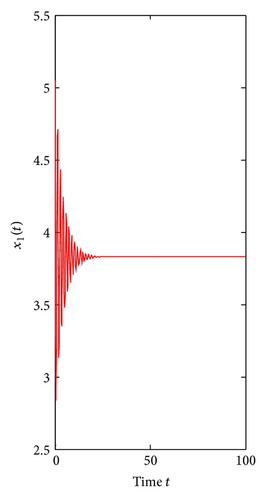
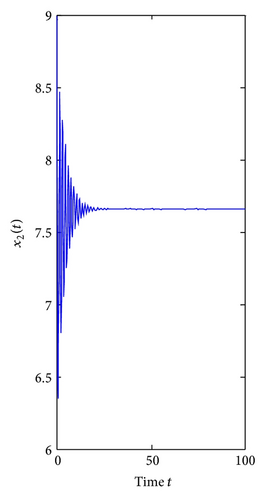
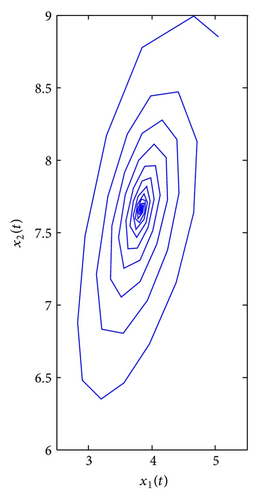

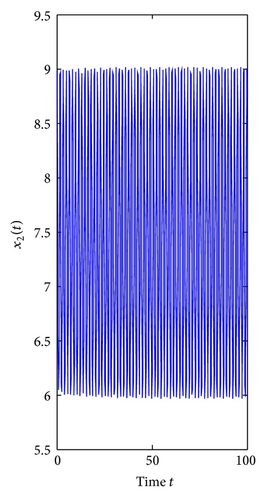
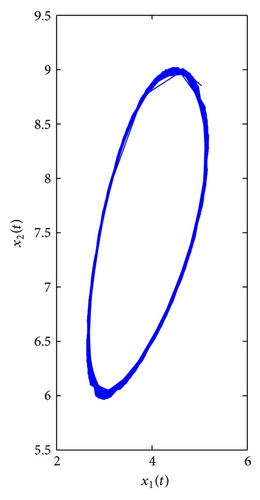
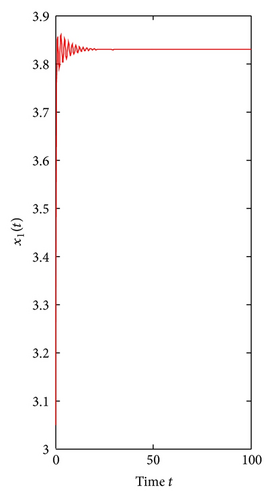
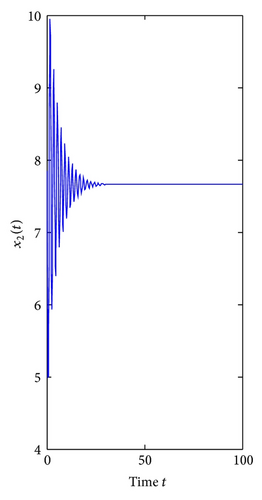
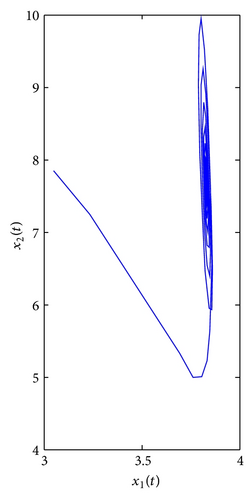
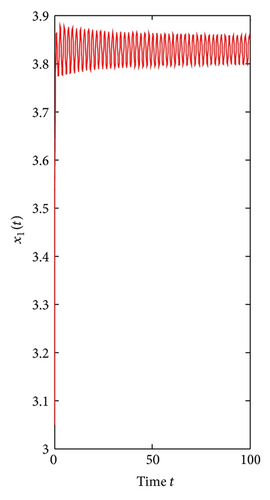
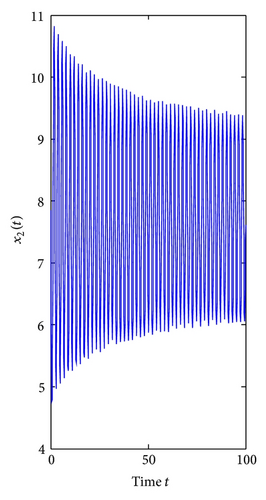
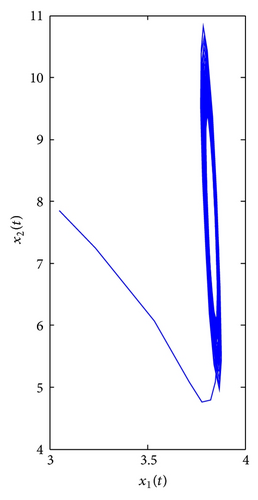
For τ1 = τ2 = τ > 0. We can obtain ω0 = 3.4601, τ0 = 0.3361. By Theorem 3, we know that when the time delay τ increases from zero to the critical value τ0 = 0.3361, the positive equilibrium E*(3.8298,7.6596) is locally asymptotically stable. It will lose its stability and a Hopf bifurcation occurs once τ > τ0 = 0.3361. This property can be illustrated by Figures 5 and 6.
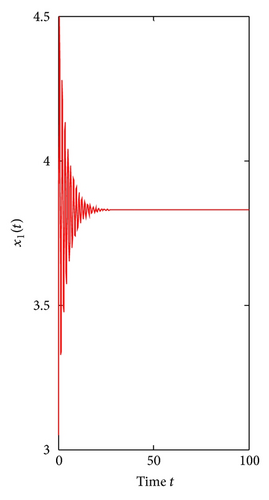
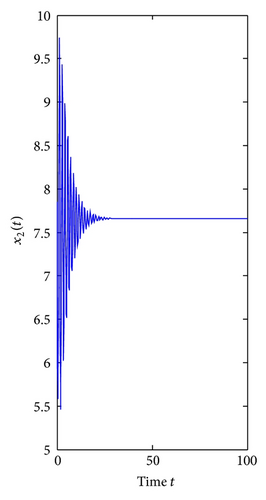
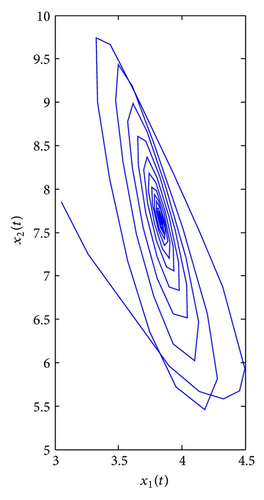
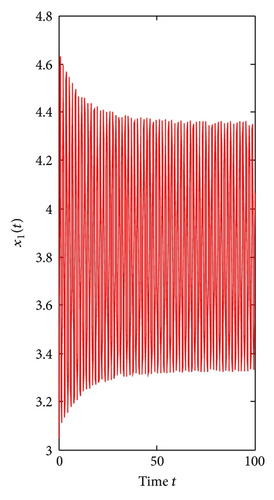
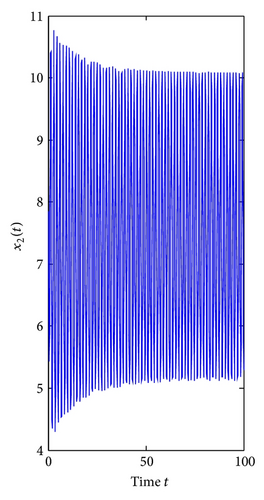
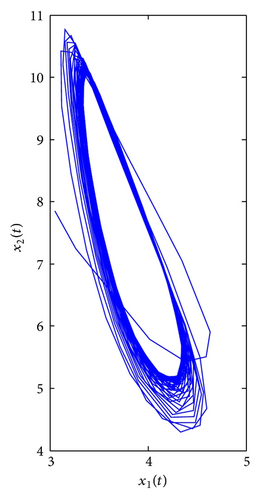
Finally, consider τ1 as a parameter and let τ2 = 0.3 ∈ (0, τ20). We can get ω1* = 2.3761, τ1* = 0.3490, λ′(τ1*) = 8.2230 + 2.6054i. From Theorem 4, the positive equilibrium E*(3.8298,7.6596) is locally asymptotically stable for τ1 ∈ [0,0.3490) and unstable when τ1 > τ1* = 0.3490, which can be seen from Figures 7 and 8.
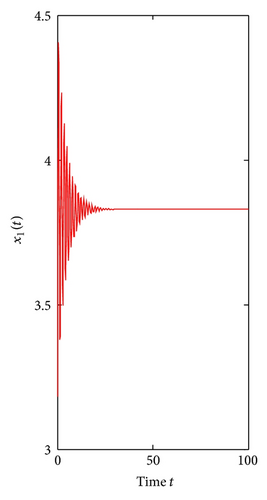
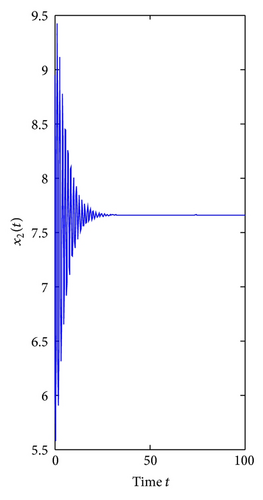
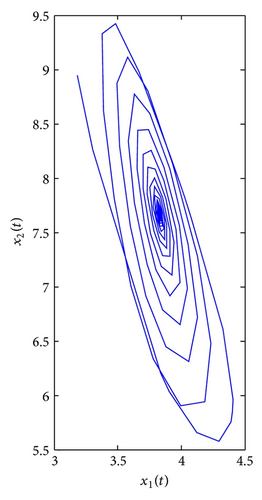
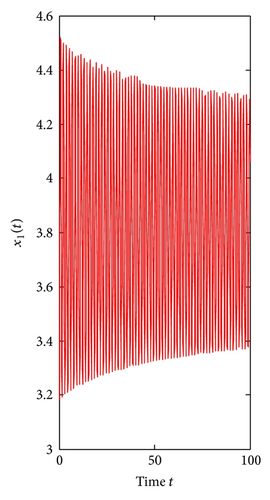

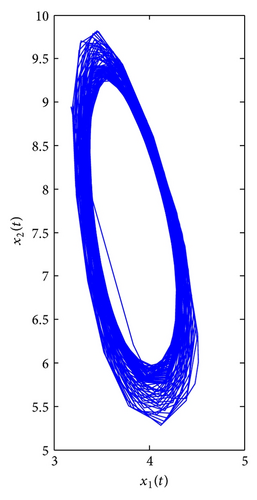
In addition, from (60), we can get C1(0) = −41.5020 − 17.8366i. Furthermore, we have μ2 = 5.0471 > 0, β2 = −83.0040 < 0, T2 = 5.6519 > 0. Therefore, from Theorem 5, we know that the Hopf bifurcation is supercritical. The bifurcating periodic solutions are stable and increase. If the bifurcating periodic solutions are stable, then the prey and the predator may coexist in an oscillatory mode. Therefore, the two species in system (3) may coexist in an oscillatory mode under certain conditions.
Conflict of Interests
The author declares that there is no conflict of interests regarding the publication of this paper.




